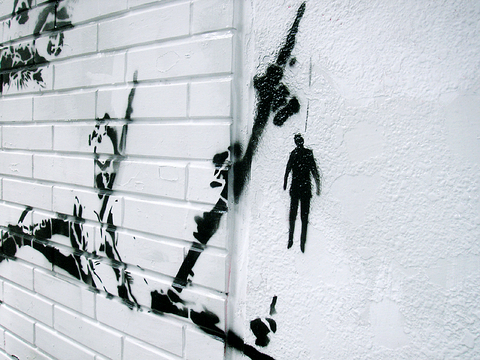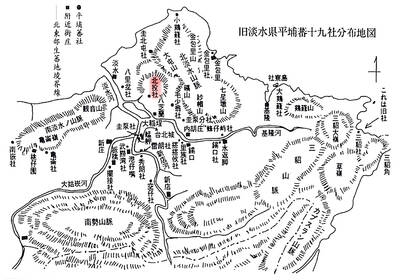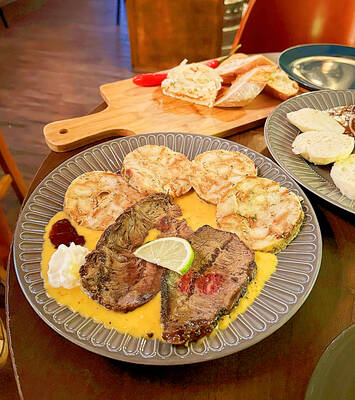Ever since Chang Shuo-yin (張碩尹), 23, was a student at the Department of Advertising at National Chengchi University (政治大學), he was taken with spraying graffiti on the walls of his campus. He also led a group called the Mountain Guerillas (上山打游擊), who converted an empty building -- refered to as "The Ruin" by local graffiti artists and connoisseurs -- into a repository of graffiti art.
Under the tag Bbrother, taken from George Orwell's novel Big Brother, Chang continues to work as a graffiti artist with a clear political bent. His vivid mural of a farmer pointing a gun to his own head, with the slogan "cheap rice hurts farmers" (穀賤傷農), is a protest against Taiwan's WTO membership. The image of a baby with its penis tied in a knot is a provocative critique of Taiwan's laws on assemblies, processions and demonstrations (集會遊行示威法). His graffiti can be seen in various parts of Taipei, including the alleys behind Eslite Book Stores (誠品台大店) near National Taiwan University (NTU), and The Ruin, which he and others wrested from police as a de facto base for their graffiti art. In spite of disagreements with local authorities regarding whether the artists could spray in The Ruin, the police have largely let them convert the abandoned building into their unofficial studio.
Lee Ming-tsung (李明璁), assistant professor in sociology at NTU, suggests that graffiti in Taiwan serves as a safety valve venting social anger, preventing young artists' pent up aggression from being expressed through violence.

PHOTO: GINGER YANG, TAIPEI TIMES
Bbrother's take on this form of street art is that it simply satisfies "the primitive desire to paint on something solid, just like ancient people painted their caves."
Few graffiti artists take their work as seriously as Bbrother, but such committed urban artists, even in limited numbers, are spearheading a genre all their own, fusing pop-art graphics with elements of traditional Chinese painting. Interestingly, while some condemn graffiti art as vandalism, others view it as a catalyst for social reform. "Graffiti cannot provide details of an issue, but it can draw attention, [provoking dialogue]," Lee said.
Big businesses have tried to appropriate the cachet of graffiti for their marketing strategies and products. Even Bbrother does occasional commercial work, but is discreet about it, perhaps aware that the anti-capitalist messages often contained in graffiti could be easily corrupted by such commercialization. Bbrother insists that he wants to keep graffiti distinct from other art genres.
Taipei has long been portrayed as a multicultural city in which the freedom of expression thrives. "I have rarely met a policeman or angry resident while painting on a wall. The police won't interrupt you if you act like a young man who loves art," Chang says. Such a statement suggests that the city indeed possesses a high threshold for expression, and that Taipei residents are very tolerant of graffiti as an artform and its proponents.

Seven hundred job applications. One interview. Marco Mascaro arrived in Taiwan last year with a PhD in engineering physics and years of experience at a European research center. He thought his Gold Card would guarantee him a foothold in Taiwan’s job market. “It’s marketed as if Taiwan really needs you,” the 33-year-old Italian says. “The reality is that companies here don’t really need us.” The Employment Gold Card was designed to fix Taiwan’s labor shortage by offering foreign professionals a combined resident visa and open work permit valid for three years. But for many, like Mascaro, the welcome mat ends at the door. A

The Western media once again enthusiastically forwarded Beijing’s talking points on Japanese Prime Minister Sanae Takaichi’s comment two weeks ago that an attack by the People’s Republic of China (PRC) on Taiwan was an existential threat to Japan and would trigger Japanese military intervention in defense of Taiwan. The predictable reach for clickbait meant that a string of teachable moments was lost, “like tears in the rain.” Again. The Economist led the way, assigning the blame to the victim. “Takaichi Sanae was bound to rile China sooner rather than later,” the magazine asserted. It then explained: “Japan’s new prime minister is

NOV. 24 to NOV. 30 It wasn’t famine, disaster or war that drove the people of Soansai to flee their homeland, but a blanket-stealing demon. At least that’s how Poan Yu-pie (潘有秘), a resident of the Indigenous settlement of Kipatauw in what is today Taipei’s Beitou District (北投), told it to Japanese anthropologist Kanori Ino in 1897. Unable to sleep out of fear, the villagers built a raft large enough to fit everyone and set sail. They drifted for days before arriving at what is now Shenao Port (深奧) on Taiwan’s north coast,

Divadlo feels like your warm neighborhood slice of home — even if you’ve only ever spent a few days in Prague, like myself. A projector is screening retro animations by Czech director Karel Zeman, the shelves are lined with books and vinyl, and the owner will sit with you to share stories over a glass of pear brandy. The food is also fantastic, not just a new cultural experience but filled with nostalgia, recipes from home and laden with soul-warming carbs, perfect as the weather turns chilly. A Prague native, Kaio Picha has been in Taipei for 13 years and